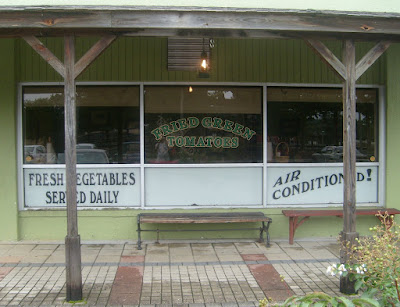 I take Highway 61 again (which I had previously taken to visit Port Gibson and Natchez), and am once more reminded not only of Bob Dylan's album Highway 61 Revisited, but – as I'm driving through the Mississippi Delta – also of David Cohn's famous words in his book God Shakes Creation (1935): 'The Mississippi Delta begins in the lobby of the Peabody Hotel in Memphis and ends on Catfish Row in Vicksburg.' We've just spent three nights in Vicksburg and are headed north, but Memphis and The Peabody Duck March are just not on the itinerary: this is supposed to be a literary trail, not a record of the tourist traps of the South. No, we're on the way to Washington. County, Mississippi, that is, and more specifically Greenville, which is about eight miles west of Highway 61, and where about 30% of the population live below the poverty line: this is a world away from the $200 a night Peabody Hotel in Memphis, Tennessee. But Greenville, from a literary point of view, is remarkable. Greenville Library is on 341 Main Street, and the street marker by the sidewalk opposite the entrance to the building proudly proclaims the literary talent that has come from Greenville, Mississippi:
I take Highway 61 again (which I had previously taken to visit Port Gibson and Natchez), and am once more reminded not only of Bob Dylan's album Highway 61 Revisited, but – as I'm driving through the Mississippi Delta – also of David Cohn's famous words in his book God Shakes Creation (1935): 'The Mississippi Delta begins in the lobby of the Peabody Hotel in Memphis and ends on Catfish Row in Vicksburg.' We've just spent three nights in Vicksburg and are headed north, but Memphis and The Peabody Duck March are just not on the itinerary: this is supposed to be a literary trail, not a record of the tourist traps of the South. No, we're on the way to Washington. County, Mississippi, that is, and more specifically Greenville, which is about eight miles west of Highway 61, and where about 30% of the population live below the poverty line: this is a world away from the $200 a night Peabody Hotel in Memphis, Tennessee. But Greenville, from a literary point of view, is remarkable. Greenville Library is on 341 Main Street, and the street marker by the sidewalk opposite the entrance to the building proudly proclaims the literary talent that has come from Greenville, Mississippi:'Greenville's Writers. An extraordinary literary atmosphere in Greenville produced winners of the Pulitzer Prize, National Book Award and O'Henry [sic] Award. Writers influenced by the creative ambience here include William A. Percy, Shelby Foote, Walker Percy, Hodding Parker, Jr., Charles Bell, Ellen Douglas, Bern Keating and David L. Cohn.' This is an extremely impressive list for a population of under 36,000.
 Greenville takes an evident pride in its literary heritage. The William Alexander Percy Memorial Library is named after the writer who was Walker Percy's uncle. Walker's grandfather, and then his father, committed suicide, and following the death of his mother in a car crash, William Alexander brought up Walker and his two brothers in Greenville. Walker Percy (1916–90) wrote novels of alienation and existentialism, and his first novel, The Moviegoer (1962), was recently voted 6th best Southern novel of all time by Southern American, the literary journal of the University of Southern Arkansas. The writer Ada Liana Bidiuc said 'If a better book than The Moviegoer has been written, I'll cut off my little toe'. They talk like that in the South.
Greenville takes an evident pride in its literary heritage. The William Alexander Percy Memorial Library is named after the writer who was Walker Percy's uncle. Walker's grandfather, and then his father, committed suicide, and following the death of his mother in a car crash, William Alexander brought up Walker and his two brothers in Greenville. Walker Percy (1916–90) wrote novels of alienation and existentialism, and his first novel, The Moviegoer (1962), was recently voted 6th best Southern novel of all time by Southern American, the literary journal of the University of Southern Arkansas. The writer Ada Liana Bidiuc said 'If a better book than The Moviegoer has been written, I'll cut off my little toe'. They talk like that in the South.



































 Ours is the Toyota Yaris, which got us through the 4000 miles.
Ours is the Toyota Yaris, which got us through the 4000 miles.













